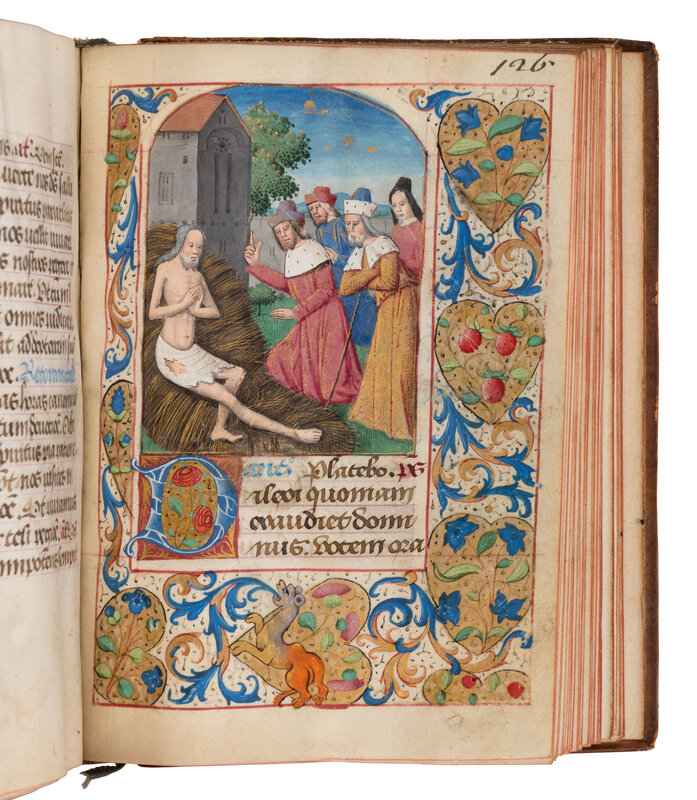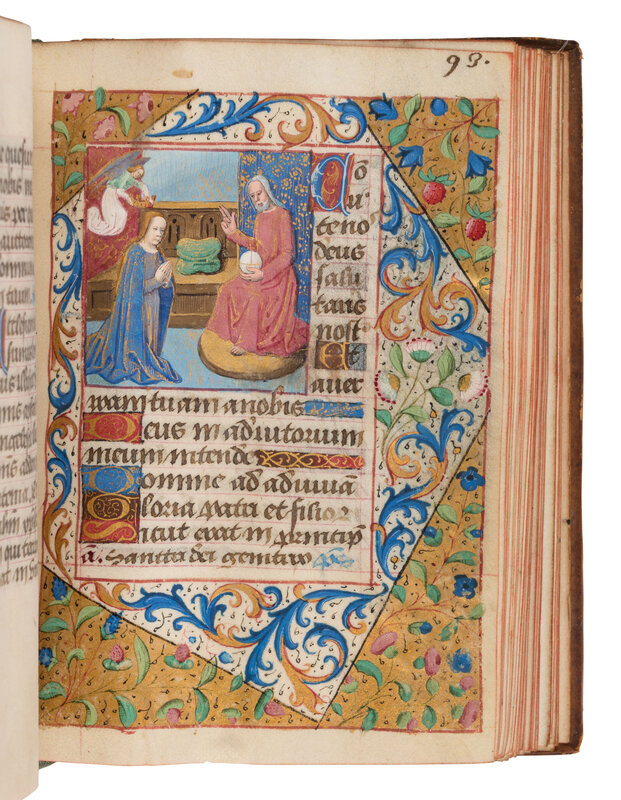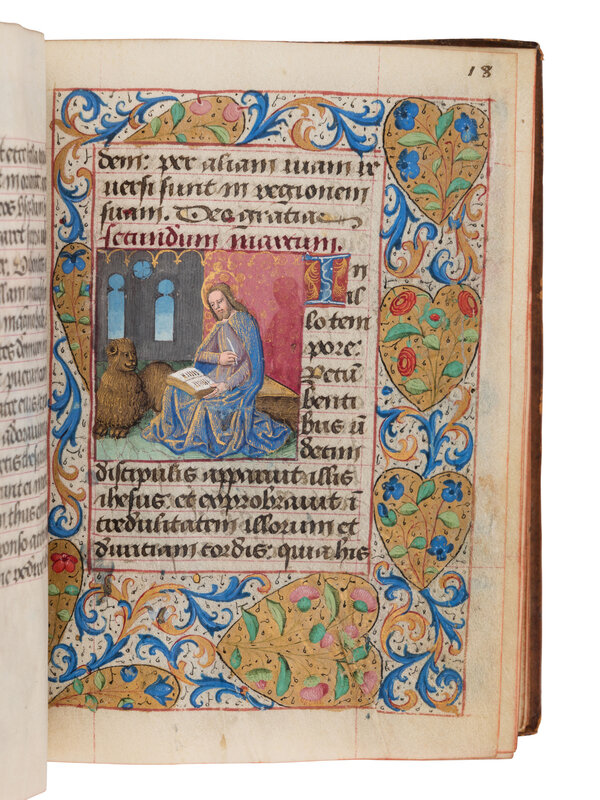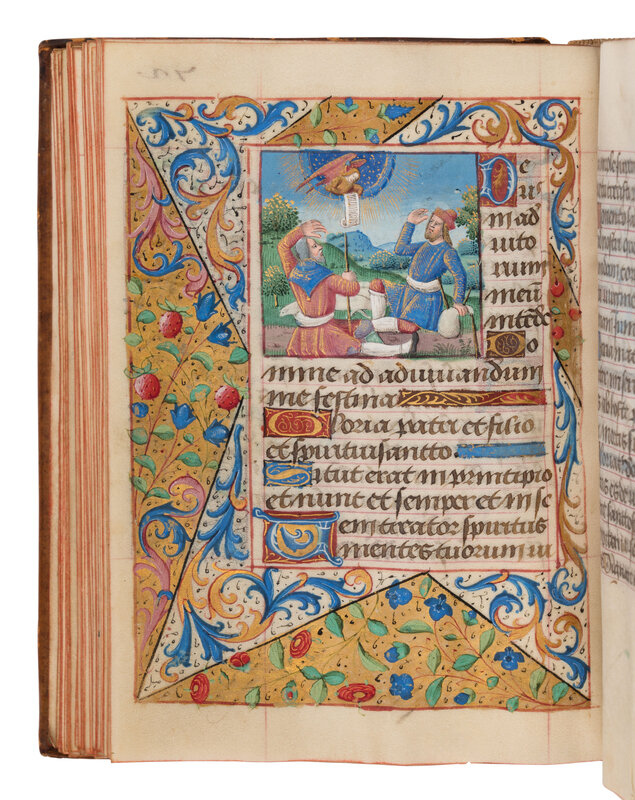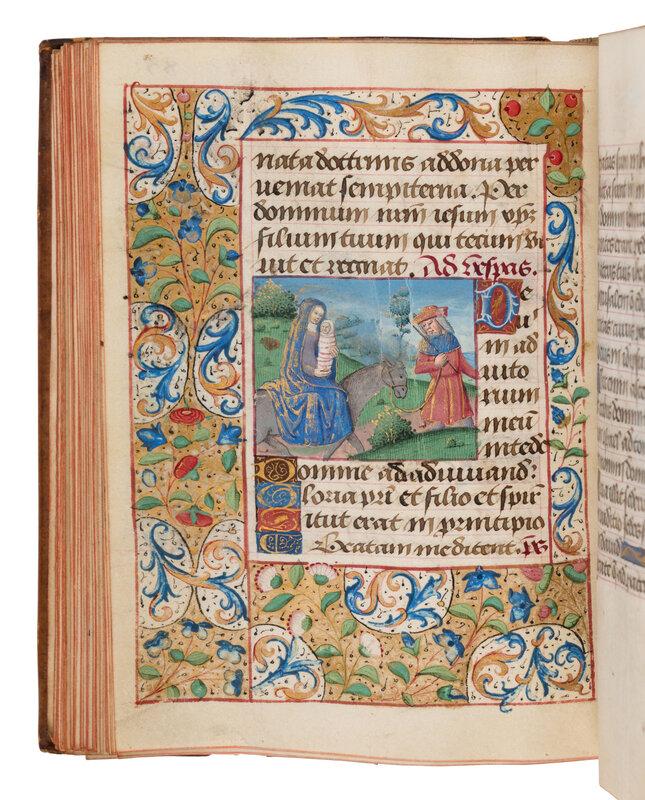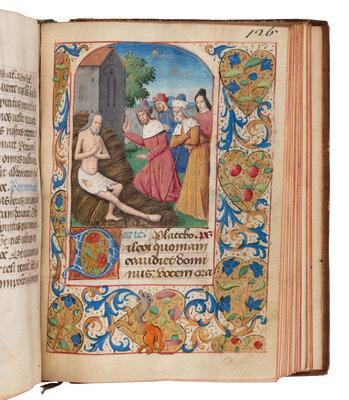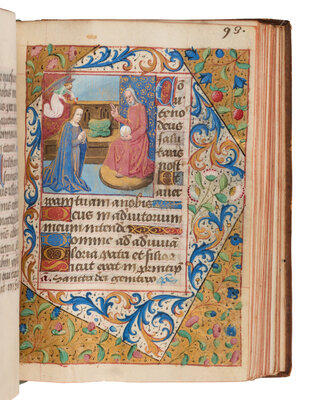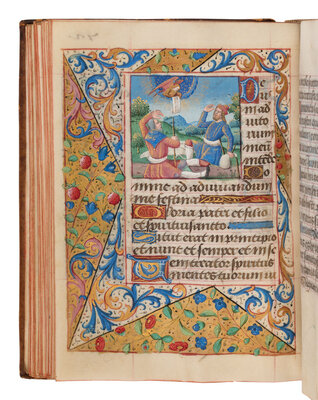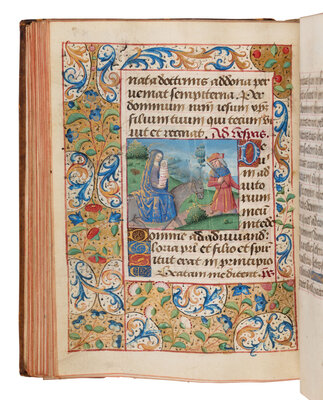Lot 64
MASTER OF THE CLUNY ROMULÉON (active Paris, c. 1480-1500)
Book of Hours, use of Paris, in Latin, illuminated manuscript on parchment [France, Paris, c. 1480-1490]
Book of Hours, use of Paris, in Latin, illuminated manuscript on parchment [France, Paris, c. 1480-1490]
Sale 2033 - Western Manuscripts and Miniatures
Jun 27, 2024
10:00AM CT
Live / Chicago
Own a similar item?
Estimate
$15,000 -
20,000
Price Realized
$12,700
Sold prices are inclusive of Buyer’s Premium
Lot Description
MASTER OF THE CLUNY ROMULÉON (active Paris, c. 1480-1500)
Book of Hours, use of Paris, in Latin, illuminated manuscript on parchment [France, Paris, c. 1480-1490]
Book of Hours, use of Paris, in Latin, illuminated manuscript on parchment [France, Paris, c. 1480-1490]
Illuminations in this manuscript constitute a fine and coherent example of the distinctive and elegant style of the Master of the Cluny Romuléon, active in Paris in the last decades of the century.
146 x 105 mm, ii (modern paper) + 174 + ii (modern paper) leaves, foliated in brown ink in a seventeenth-century hand in the top outer corner, 1-181, with mistakes, followed here, lacking five leaves with large miniatures and two leaves with small miniatures, else complete [collation: i8, ii4, iii8, iv8-1 (after f. 26, with large miniature), v-x8, xi8-2 (foliated 77 and 80, both with small miniatures), xii8, xiii4-1 (after f. 95, with large miniature), xiv6, xv-xvi8, xvii8-2 (after ff. 118 and 123, both with large miniatures), xviii-xxiii8, xxiv6], ruled in red for one column of 16 lines (written space: 82 x 58 mm), written in brown ink in a gothic bastarda script, capitals touched with yellow, rubrics in blue, one-line initials in liquid gold on alternately red and blue ground, line-fillers in same, two-lines initials in blue on burnished gold and red ground, highlighted with white and liquid gold, ONE-SIDED FLORAL BORDER ON EVERY PAGE, associating a short composition of gold vine leaves and colored flowers on the versos, with a panel border of the same between two reds on the rectos, TWO HISTORIATED INITIALS of six lines in blue on red ground, with highlights of white and liquid gold, accompanied with a full compartmented border of acanthus sprouts and colored flowers on alternating blank and liquid gold ground, EIGHT SQUARE MINIATURES, accompanied with a full border of the same, ONE LARGE ARCH-TOPPED MINIATURE, accompanied with a full border of the same, with heart-shaped compartments (slight cockling of the parchment, occasional stains and ink transfers, minor flake on the miniature on f. 53v, dampstain on ff. 1-2, else in good condition). Bound in a eighteenth-century brown morocco binding, spine gilt-tooled and raised on five bands, with leather title-piece “Heures ancienne,” flyleaves in marbled paper, green silk ribbon, edges gilt (lower headband worn, slight openings at the junction of the headbands, corners quite scuffed, loss of gilt on top edges, else in good condition).
Provenance
(1) This manuscript was illuminated in Paris in the 1480s or 1490s by the Master of the Cluny Romuléon for an anonymous patron who probably lived in the city, considering the choice of local saints in the calendar and the liturgical use of Paris.
(2) A prayer was added in an early sixteenth-century hand on ff. 118v-119, presumably because the following leaf was already missing.
(3) Abbot Loreau, Dijon; given by him in Dijon on 3 May 1765 as a gift to John Conyers, as reported by the latter in a handwritten note on the second flyleaf.
(4) John Conyers (1717-1775), member of the Parliament of Great Britain, his library at Copt Hall, Essex, as confirmed by the print bookplate affixed on the front pastedown.
(5) Aline Thorold (1869-1951) m. Ernest James Wythes (1868-1949) at Copped Hall, Essex, until 1917 and The Wood House, Essex, thereafter and by descent to -- Barbara Dorothy Wythes (1896-1984) m. (Francis) Guy Robert Elwes (1895-1966) at The Wood House, Essex until 1961 and Ham Spray House, Marlborough, thereafter and by descent to
Aline Mary Margaret (Elwes) McDonnell (1923-2023) m. Hubert McDonnell Jr. (1919-2004), Greenwich, Connecticut, and thence by descent.
Text
ff. 1-12, Calendar, in blue, gold, and red; ff. 13-19, Gospel Sequences; ff. 19-25v, Obsecro te; ff. 25v-26v, O Intemerata; ff. 27-95v, Hours of the Virgin (use of Paris, beginning imperfectly), with Lauds, f. 53v, Prime, f. 66v, Terce, f. 72v, Sext, f. 78v (beginning imperfectly), None, f. 82 (beginning imperfectly), Vespers, f. 85v, Compline, f. 93 (ending imperfectly); ff. 96-109, Penitential Psalms (beginning imperfectly); ff. 109-118v, Litany and Prayers (ending imperfectly); ff. 119-123v, Hours of the Cross (beginning imperfectly); f. 123v, blank, ruled; ff. 124-125v, Hours of the Holy Spirit (beginning imperfectly); ff. 124-181v, Office of the Dead.
Illumination
This charming Book of Hours has benefited from subtle decoration throughout, associating a compartmented border with a vine scroll on each text opening of the manuscript, alongside an extensive cycle of historiated compositions. The miniatures and historiated initials are due to the elegant hand of the Master of the Cluny Romuléon, whose style is readily recognized by the rounded square-shape of the face, the reddish flesh-tones of the male figures, and the abundant use of liquid gold with vivid colors. The modeling of Job on the Dungheap in thin brushstrokes as well as the gold arches framing the small miniatures are characteristic of his early production. Indeed, these relate quite closely to the manuscript of Jacques de Cessole’s Jeu des échecs moralisés (Paris, BnF, MS fr. 2000; see Avril and Reynaud 1993, no. 213, p. 376), which includes the arms of Nicolas of Anjou, Duke of Lorraine (1470-1473), but was likely illuminated from the early 1480s onward. That a similar date would apply to the present manuscript is confirmed by the fact that several of these miniatures also rely on models used in a Book of Hours for the use of Langres in New York (Morgan Library and Museum, MS M.26), especially the Coronation of the Virgin and Job on the Dungheap.
First named the Master of Morgan 26 by John Plummer in 1982, the Master of the Cluny Romuléon was renamed by François Avril after scattered fragments of a Romuléon in the translation by Jean Miélot (Paris, Musée de Cluny, inv. 804, inv. 1819; see Delaunay 2000), perhaps commissioned by René II of Lorraine. Since a number of his clients came from Eastern France, the Master of the Cluny Romuléon could have begun his career in Lorraine or Champagne. However, he appears to have been active in Paris early on, and he probably knew Master François if one considers the similarities in their palette, models, and taste for openwork golden frames, as is illustrated here by the Coronation of the Virgin. That he was active in Paris in the mid-1480s is further demonstrated by the liturgical use, textual content, and secondary decoration of the present manuscript, which favors compartmented borders reflecting the parallel trends of manuscript illumination in late-fifteenth century Paris.
The subject of the large miniature is: f. 126, Job on the Dungheap. The subjects of the eight miniatures and two historiated initials are: f. 14v, St. Luke; f. 16, St. Matthew; f. 18, St. Mark; f. 19, Pietà (initial O); f. 23v, Virgin and Child (initial O); f. 53v, Visitation; f. 66, Nativity; f. 72v, Annunciation to the Shepherds; f. 85v, Flight into Egypt; f 93, Coronation of the Virgin.
LITERATURE
Further literature on the artist, see: John Plummer, The Last Flowering. French Painting in Manuscripts, 1420-1530, New York/London, 1982, no. 94, pp. 72-73; François Avril and Nicole Reynaud, Les Manuscrits à peintures en France, 1440-1520, Paris, 1993, no. 213, 376; Isabelle Delaunay, Échanges artistiques entre les livres d’heures manuscrits et imprimés produits à Paris vers 1480-1500, PhD dissertation, Paris, 2000.
Freeman’s | Hindman thank Senior Consultant Sandra Hindman and Elliott Adam for their assistance in preparing this sale.
This lot is located in Chicago.
Property from the Aline Elwes McDonnell Trust
Condition Report
Contact Information
